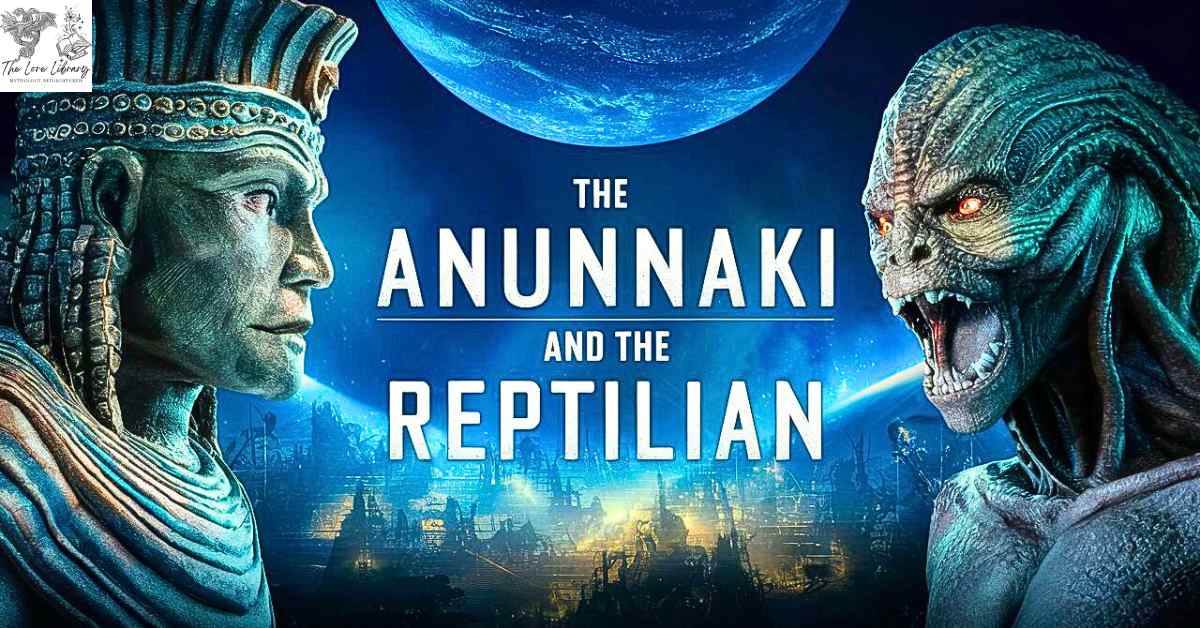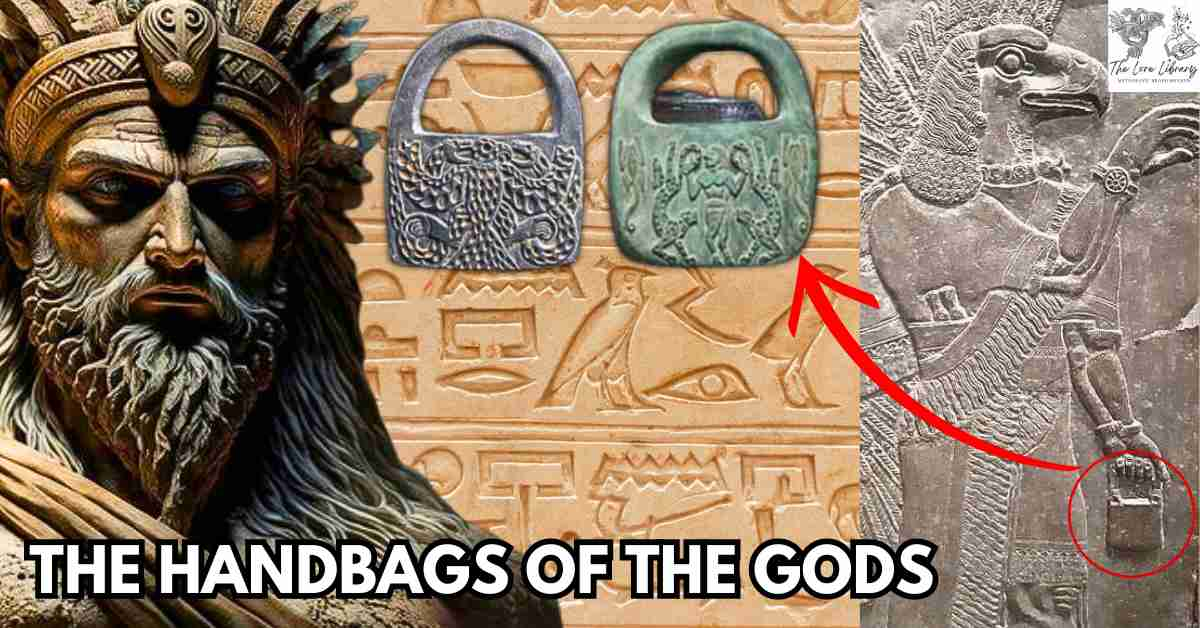Believe it or not, the question of whether the Anunnaki were a race of reptoids has only been around a bit over 20 years. The only reason it came about was because of a journalist who decided to become an author and create what is now known as the Reptilian Agenda Conspiracy.
Many of you are likely familiar with David Icke. If you are not, we will get to Ike later in the post, but for now, it is only important to know what the conspiracy posits.
According to the reptilian agenda conspiracy, a race of bloodthirsty reptilian aliens first arrived on Earth hundreds of thousands of years ago.

The Anunnaki and the Reptilian Conspiracy
The story goes that these beings merged with humans through the manipulation of DNA, as well as interbred with the human population. This is supposedly still going on today. The goal of this process was to gain control of the world by obtaining positions of power and influence – for example, royalty, politicians, business moguls, popular entertainers, etc.
Over the years, a question that we receive regularly from many of our readers is whether or not these so-called reptilians are the Anunnaki. Keep in mind this is a nuanced question that requires a rather nuanced answer. The reason we say this is because the question itself already presumes the existence of reptilians, but it is not the intent of this post to confirm or deny such existence.
The nuance of this discussion is tightly focused on whether the Anunnaki were reptilians or not, and that question can be answered regardless of one’s belief about the existence of reptilian humanoids. Even though this type of post will undoubtedly disappoint a certain portion of our viewers, We have decided to address this long-standing line of inquiry and we decided to provide a response using the full context of our perspective on The Anunnaki and the Reptilian Conspiracy.
Serpent Symbolism in Ancient Cultures
In that effort, we believe it is vital for our readers to understand the history of serpent symbolism in various ancient cultures and how that symbolism has been hijacked by modern day conspiracy theorists to distort and pervert an otherwise serious investigation into our origins. So in case you are wondering why we are starting with the serpent symbolism topic, and not directly arguing on The Anunnaki and the Reptilian Conspiracy, it is because this is an overview of some of the ancient references used by proponents of the reptilian agenda conspiracy to form their premise.
The serpent is one of the oldest and most widespread mythological symbols in our recorded history. The word is derived from the Latin serpens, meaning a crawling animal or snake. Snakes have been associated with some of the oldest rituals to mankind and represent a duality of good and evil. Historically, serpents and snakes represent fertility or a creative life force. As snakes shed their skin through sloughing, they are symbols of rebirth, transformation, immortality, and healing.

In many ancient cultures, the caduceus or sometimes a rod serpent lives in or is coiled around a tree of life situated in a divine garden. Sometimes the tree of life is represented by a staff such as those used by shamans. Examples of such staffs featuring coiled snakes are the caduceus of Hermes, the rod of Asclepius, the staff of Moses, and the papyrus reeds and deity poles entwined by a single serpent waget dating to earlier than 3000 BCE.
The oldest known representation of two snakes entwined around a rod is that of the Sumerian god Ningishzida, who was sometimes depicted as a serpent with a human head, eventually becoming a god of healing and magic. In the Louvre there is a famous green vase carved for King Gudea of Lagash with an inscription dedicated to Ningishzida.
Ningishzida was also the ancestor of Gilgamesh who, according to the epic, dived to the bottom of the waters to retrieve the plant of life. But while he rested from his labor, a serpent came and ate the plant. The snake became immortal and Gilgamesh was destined to die. Ningizita is another name for the ancient Hindu concept Kundalini, a Sanskrit word meaning either coiled up or coiling like a snake.
Kundalini refers to the mothering intelligence behind spiritual maturation leading to altered states of consciousness. The staff represents the spinal column with the snakes being energy channels. In the case of two coiled snakes, they usually cross each other seven times, a possible reference to the seven energy centers called chakras.
Some of you may be wondering about Enki. He was a serpent god too, right? Well, contrary to the reptilian conspiracy and even the Ancient Aliens TV show for that matter, Enki is not really a serpent god. Even the TV show gets this completely wrong, with one of the show commentators in Season 14 Episode 8 stating that Enki is depicted as half-serpent, half-man. It is simply not true. It is true, however, that Enki became associated with the serpent as a result of his conflict with his brother Enlil.
In ancient Egypt, the serpent appears from the beginning to the end of their mythology. The uraeus is a symbol for the goddess Wadjet. She was one of the earliest Egyptian deities and was often depicted as a cobra. The pharaohs wore the uraeus as a head ornament, either with the body of Wadjet atop the head or as a crown encircling the head. This indicated Wadjet’s protection and reinforced the pharaoh’s claim over the land. In whatever manner that the uraeus was displayed upon the pharaoh’s head, it was in effect part of the pharaoh’s crown. The pharaoh was recognized only by wearing the uraeus, which conveyed legitimacy to the ruler.
In the early years, the uraeus symbolized mastery of the kundalini and the self. Indeed, the Egyptians were also aware of the kundalini energy, and the serpent provided the symbolism to depict the two worlds of the physical and astral bodies known as the crocodile god Sobek. Sobek protected the Egyptian army, the pharaohs, and the ancient Egyptian people. Sobek first appeared in the Old Kingdom and is portrayed as a full crocodile or as a human with a crocodile head.
Thoth, the bringer of wisdom, is sometimes found holding two snakes. Notably, Thoth became Hermes to the Greeks, Mercury to the Romans, and the caduceus he holds is a clear depiction of the vital energy that is our true essence.
Nāga is the Sanskrit word for a deity or class of entity or being taking the form of a large snake found in Hinduism and Buddhism. The nāga primarily represents rebirth, death, and mortality due to its casting of its skin and being symbolically reborn. Hindus associated nāga with Shiva and with Vishnu, who rested on a 100-headed nāga and was coiled around Shiva’s neck. The snake represented freedom in Hindu mythology because it cannot be tamed.

In the Hebrew Bible, the serpent in the Garden of Eden lured Eve with the promise of being like God. The process of how Judeo-Christian religion has transformed this serpent into Satan is detailed in our presentation titled “Brotherhood of the Snake.” It is highly recommended and a link is in the description.
Serpents figured prominently in archaic Greek myths. According to some sources, Ophion ruled the world with Eurynome before the two of them were cast down by Cronus and Rhea. The oracles of the ancient Greeks were said to have been the continuation of the tradition begun with the worship of the Egyptian cobra goddess Wadjet.
Typhon, the enemy of the Olympian gods, is described as a vast grisly monster with a hundred heads and a hundred serpents issuing from his thighs, who was conquered and cast into Tartarus by Zeus. Python was the earth dragon of Delphi. She always was represented in the vase paintings and by sculptors as a serpent. Python was the enemy of Apollo who slew her.
Medusa and the other Gorgons were vicious female monsters with sharp fangs and hair of living, venomous snakes whose origins predate the written myths of Greece and who were the protectors of the most ancient ritual secrets. The Gorgons wore a belt of two intertwined serpents in the same configuration of the caduceus of Asclepius.
Asclepius, the son of Apollo, in Corinth learned the secrets of keeping death at bay after observing one serpent bringing another back to life with healing herbs. Asclepius was frequently represented standing dressed in a long cloak with bare breast. His usual attribute was a staff with a serpent coiled around it. This staff is the only true symbol of medicine. A similar but unrelated emblem, the caduceus with its winged staff and intertwined serpents, is frequently used as a medical emblem but is without medical relevance since it represents, as mentioned earlier, the magic wand of Hermes or Mercury.
Native Indian tribes of the Americas have the depiction of the plume serpent, also referred to as the creator god and the god of the underworld. A prime example is the serpent god of the native Mesoamericans, Quetzalcoatl to the Aztecs and Kukulkan to the Maya.
The Rainbow Serpent, also known as the Rainbow Snake, is a major mythological being for Aboriginal people across Australia, although the creation myths associated with it are best known from northern Australia.

Before we close out this segment on symbolism, we would like to discuss the Ubaid lizard figurines. The Ubaid period is a prehistoric period of Mesopotamia spanning from 6500 BCE to 3800 BCE. In 1923, several Ubaid statues were discovered that depict strange lizard-like humanoid figures. Their unceremonious poses seem to indicate they were not gods. There are many theories and interpretations but relatively little evidence to support them because there are no written sources from the Ubaid period.
Of course this has not stopped the Ancient Aliens TV show or Icke from claiming them as reptilians. Indeed, the appearance of these figurines is compelling, but one of the few things that can safely be theorized about them is their cranial shape. These almost certainly represent skulls that were bound in infancy to deliberately modify the shape. The practice of intentional cranial deformation by binding the skull in infancy is strongly supported by skeletal evidence from a number of fifth millennium sites in the region. Proponents of the reptilian agenda conspiracy conveniently omit this fact.
The Origin of the Reptilian Humanoid Trope
The examples of serpent symbolism throughout human history go on and on. We could produce an entire series on this subject alone, but it’s time to get to the point.
So in the previous section of serpent symbology, did you catch any reference to actual reptilian humanoids? The ancient texts and other artifacts of these various cultures do indeed describe some anthropomorphic gods who are half serpent in one way or another, and some of the gods are actual serpents in a few cases. However, none of them describe fully reptilian humanoids. The concept of a reptilian humanoid is a rather modern invention.
You may be wondering okay, so when and where did this reptilian concept truly originate? The answer is modern-day fiction. The serpent men reptilian humanoids who can project illusions of human form appeared as villains throughout Robert E. Howard’s Kull stories starting in 1929. Edgar Rice Burroughs’ Pellucidar series featured primitive dinosaur-descended humanoids living in the hollow Earth called the Horibs or Snake Men. In his 1929 crossover Tarzan at the Earth’s Core, these almost simultaneous works of fiction originated the modern reptilian humanoid trope.
David Icke’s Reptilian Agenda
But how did these fictional works transform into the current version of the conspiracy?
Many of our Readers are familiar with Nancy Lieder because We have referenced her several times regarding the Nibiru catastrophe conspiracy. In short, in the late 1990s Lieder began turning out predictions of an imminent collision with the planet Nibiru. After one prediction would fail, she would simply issue a new date and regurgitate the same crap over and over. In essence, she used the serious research of individuals in this field of study to manifest a complete doomsday hoax.

Then once the YouTube generation came on the scene, every doomsdayer out there with the ability to post a video online crawled out of the woodwork to help bastardize the subject. The concept of reptilian humanoids has followed a remarkably similar track.
According to British conspiracy theorist David Icke, who first published on this theme in 1999 with his work “The Biggest Secret”, tall blood-drinking, shape-shifting reptilian humanoids from the Alpha Draconis star system now hiding in underground bases are the force behind a worldwide conspiracy against humanity. According to Icke, these beings have been merging with humans through the manipulation of DNA by a group known as the Anunnaki, as well as interbreeding with the human population.
The goal of this process was to gain control of the world by obtaining positions of power and influence. He contends that most of the world’s ancient and modern leaders are related to these reptilians, including the Merovingian dynasty, the Rothschilds, the Bush family, and the British royal family.
Icke also references several Bible passages – a serpent tricking Eve into eating an apple, the Nephilim interbreeding with humans, Satan’s characterization as a serpent or dragon-like being. Icke’s interpretations of passages in the Bible seem to play a large role in this belief system. Given these phrases were rather ambiguous in the first place, it would be easy for Icke to connect them to his theory
Another example of a misinterpretation is the video glitch that makes people look like they are shape-shifting. Proponents of the conspiracy argue that slowing down or pausing video can sometimes reveal a glimpse of individuals shape-shifting. However, this shape-shifting is really a glitch known as compression artifact.
Brian Dunning explains it well in his book “Conspiracies Declassified”:
“In recent years there has been less repetition of the conspiracy theorists’ claims when it comes to the video evidence of the reptoids. The reason for this decline is likely the advent of high definition video. Today when we pause a video there is much less compression artifacting. In fact most of the time you can’t see any at all. But when David Icke first began promoting this idea, pausing video meant pausing a VHS tape.
If you remember seeing this you will recall that when paused the picture would jitter and flash and sometimes flicker between two frames, and that every edge was shattered into interlacing lines. It was easy in those days to pause a video and see just about anything you wanted to see. And in the early days of YouTube with low resolution, highly compressed videos the situation was only marginally better.”
The Reptoid theory is heavily reinforced by confirmation bias. Icke has been able to mold evidence in favor of his hypothesis. Furthermore, those who have become attached to Icke’s point of view have also developed the ability to interpret supporting information from vague sources. This belief system may also be connected to a desire for structure out of randomness. It is easier to explain how our world leaders manage to gain such positions of power by linking them to a specific group. This process possibly provides a sense of comfort to the believers. They can imagine having power over the leaders by knowing their true identities.
It should be noted that the reptoid theory is not popular by comparison to other theories. Therefore, a number of Icke’s followers are likely motivated by a desire to feel unique, kind of like flat earthers. With these factors in mind, it is no wonder why many are captivated by the reptoid theory.
The Anunnaki and Reptilian Conspiracy is False
Now we want to be very clear in our refutation of Icke’s premise. We vehemently argue that Icke’s so-called reptoids have no relationship whatsoever to the Anunnaki. Period.
We are not necessarily arguing against the potential existence of a reptoid alien race, nor are we unequivocally denying that such a race could have intervened in ancient Earth’s history. Rather, the Archive is tightly focused on the completely invalid connection made by Icke between reptoids and the Anunnaki.
Icke has hijacked the research conducted by legitimate individuals, primarily Zechariah Sitchin, and perverted it into some sensationalized version of the Land of the Lost. Sitchin is the foremost authority on the Anunnaki and their role in the ancient astronaut hypothesis. He never, and I repeat never, spoke about, referenced, or described any reptilian race in his many works and presentations. He never assigned any reptilian characteristics to the Anunnaki.
And as far as the veracity and reliability of research is concerned, We will pick Sitchin over Icke every day of the week. Sitchin was the real deal when it concerns in-depth research of this subject matter. Comparing Sitchin’s work to Icke’s is like comparing a university library with a gas station newsstand.
We are fully aware that a post like this could possibly alienate some readers, but the truth is much more important to Us. Just like with the Nibiru catastrophe and Black Knight satellite conspiracies, our interest is to point out how the ancient astronaut hypothesis is being co-opted into a broader pop culture hoax. Most often, the proponents of these conspiracies have a direct financial benefit derived from their continued propagation.
So when anyone, no matter who they are, tries to co-opt such an endeavor for their own financial gain, we’re going to point this out. The question may arise for some of you as to why the Lore is so certain the Anunnaki were not reptilian. We can start by declaring that not a shred of evidence has been found in the ancient Sumerian text, seals, and artifacts indicating such a race existed during that time period. If there was a reptilian race involved with ancient Mesopotamian pre-history, Zechariah Sitchin would have certainly discussed it. He certainly had no compunction whatsoever talking about the snake symbolism found in various ancient cultures or anything else.
Shop amazing Anunnaki Merchandise at our store, Follow us on Facebook, Instagram, And For More Interesting Content Also Subscribe To Our Youtube Channel.










I think you are full of denial! People have seen these Reptillians! They’ve seen humans turn into Reptillians by shapeshifting. Queen Elizabeth was one as was prince charles.